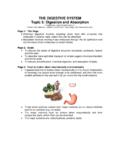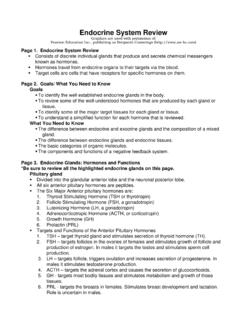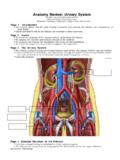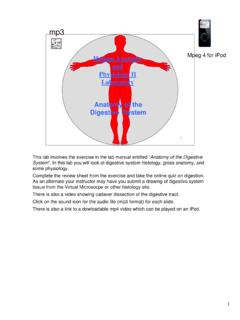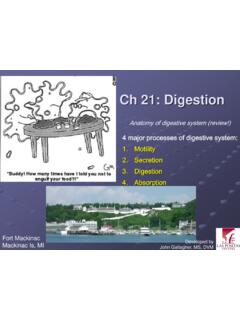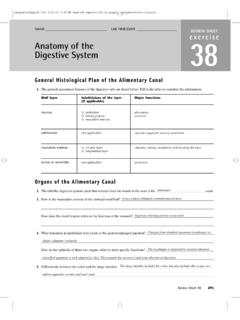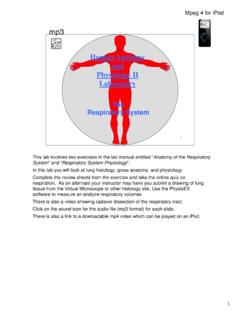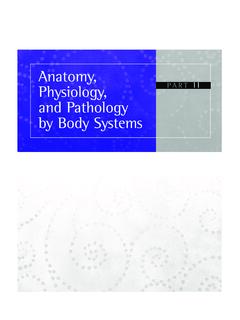Transcription of Anatomy Review: Digestive System
1 THE Digestive System Topic 2: Control of the Digestive System Graphics are used with permission of: Pearson Education Inc., publishing as Benjamin Cummings ( ) Page 1: Title Page The autonomic nervous System , hormones, and other chemicals control motility and secretion of the Digestive System . The Autonomic Nervous System Sympathetic Parasympathetic Page 2: Goals To list the phases of GI control To describe the interaction between the enteric and autonomic nervous systems To discuss short and long reflexes. To list the hormones that control digestion and describe the function of each hormone.
2 Page 3: Control of the GI tract depends on the location of food The sight, smell, taste, and mental images of food trigger the cephalic phase of digestion via the vagus nerve (N X) which includes: o salivation o gastric juice production o gastric contractions Increased volume of food in the stomach and subsequent stimulation of stomach stretch receptors triggers the gastric phase of digestion which includes: o gastric juice production o increased gastric motility As food moves into the small intestine (duodenum), the chemical composition and volume of that food triggers specific reflexes during the intestinal phase of digestion which may include.
3 O pancreatic secretion of bicarbonate into the duodenum o pancreatic secretion of Digestive enzymes into the duodenum o gall bladder release of bile into the duodenum o segmentation contractions of the small intestine The small intestine reflexively slows gastric emptying to allow for neutralizing, enzymatic digestion, and absorption of its contents Page 4: Parasympathetic and sympathetic nerves innervate the GI tract Both parasympathetic and sympathetic divisions of the autonomic nervous System control digestion by contacting the enteric nervous System in the wall of the Digestive tract The parasympathetic division typically stimulates digestion while the sympathetic division typically inhibits it.
4 The vagus and pelvic splanchnic nerves send preganglionic parasympathetic fibers to synapse with enteric neurons. Sympathetic postganglionic innervation of the Digestive tract is both direct to smooth muscle, glands, and blood vessels and indirect via synapses with the enteric NS. LABEL THE NERVE FIBERS BELOW The Autonomic Nervous System Preganglionic fiber of Vagus nerve Postganglionic fiberPreganglionic fibers of pelvic splanchnic nerves Page 5: The enteric nervous System serves the GI tract The submucosal and myenteric plexuses are the two nerve networks of the enteric nervous System .
5 The enteric nervous System controls many Digestive functions independent of the rest of the nervous System , such as lower esophageal peristalsis and mobility of the small intestine. Parasympathetic Division Sympathetic Division Page 6: Reflexes coordinate and modulate Digestive activity Reflexes (stimulus, integration, and response) that are totally controlled by the enteric nervous System are termed short reflexes. Reflexes that involve the CNS as an integration center are called long reflexes Short and long reflexes can occur simultaneously Larger volumes of food in the stomach produce stronger gastric contractions than smaller volumes of food.
6 Small volume weaker contractions Large volume stronger contractions Chemical composition of food influences the rate of digestion: lipid rich meals take longer to digest than carbohydrate rich meals Lipid rich meal Longer digestion time Carbohydrate rich meal shorter digestion time Emotional stressors cause the brain to override the intrinsic controls of digestion and subsequently cause problems such as constipation, diarrhea, and stomachaches. Page 7: There are many neurotransmitters in the GI tract All preganglionic fibers of the ANS release acetylcholine (ACh).
7 Parasympathetic postganglionic fibers also release ACh Sympathetic postganglionic fibers release norepinephrine LABEL THE FIBERS BELOW AND INCLUDE THE NEUROTRANSMITTER RELEASED BY THE FIBER The Autonomic Nervous Preganglionic fiber of Vagus nerve Other enteric nervous System neurotransmitters include serotonin, vasoactive intestinal peptide (VIP), nitric oxide (NO), and somatostatin (SST) ACh and substance P stimulate smooth muscle of the Digestive tract.
8 Smooth muscle of the Digestive tract is inhibited by norepinephrine, VIP, and NO Enkephalins released in the submucosal and myenteric plexuses slow intestinal motility, inhibit intestinal secretion, and contract the LES, pyloric and ileocecal sphincters. Parasympathetic NS Sympathetic NS (releases ACh) Postganglionic fiber(releases norepinephrine) Preganglionic fibers of pelvic splanchnic nerves (releases ACh) Postganglionic fiber (releases ACh) Preganlionic fiber (releases ACh) Page 8: Hormones modulate Digestive activity GI hormones are peptides (amino acid based).
9 GI hormones include gastrin, cholecystokinin (CCK), secretin, glucose-dependent insulinotropic peptide (GIP) and motilin. Enteroendocrine cells of the GI mucosa secrete the peptide hormones. Pyloric antrum G cells secrete gastrin, which stimulates HCl production and growth of the gastric mucosa CCK is secreted by the I cells in the duodenum and jejunum. CCK cause gall bladder contraction and subsequent release of bile into the duodenum CCK causes the pancreas to release Digestive enzymes into the duodenum CCK inhibits gastric emptying CCK stimulates growth of the pancreas and gall bladder mucosa Duodenal S cells produce secretin Secretin causes the pancreas, and to a lesser extent the liver, to release bicarbonate into the duodenum Secretin inhibits HCl secretion by the stomach Duodenal and jejunum cells secrete GIP When glucose is present.
10 GIP stimulates the pancreas to secrete insulin, thus enhancing the secretion of insulin Duodenal and jejunum cells secrete motilin during the postabsorptive state Motilin stimulates GI motility thereby moving intestinal contents toward the end of the ileum 1. GI hormones, like all hormones, enter the circulatory System , and then return to the target organ(s); in this case, back to the GI tract. 2. Potentiation of hormones involves the combined effect of two or more hormones being greater than the sum of their individual actions Study Questions on Digestive System Control:1.
